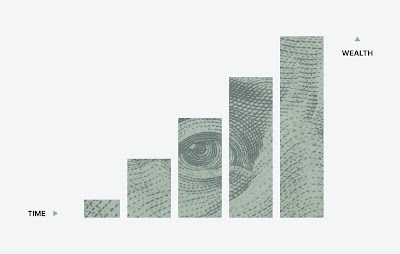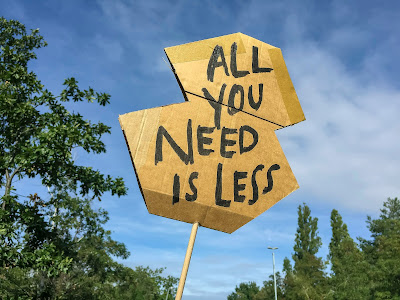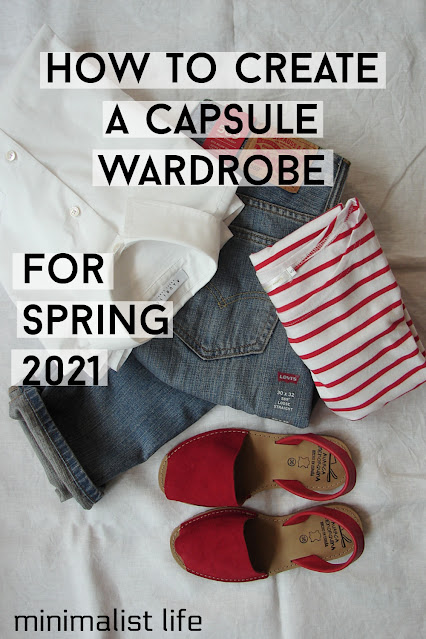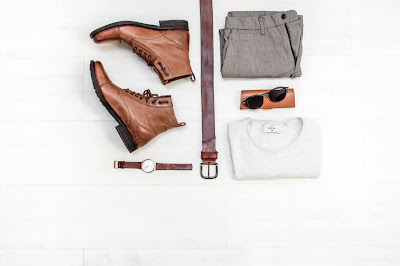Behind the coronavirus and the government, Gallup polls from March 2021 show that Americans consider economic issues (as a whole) the third most important problem today.
I don't have any solutions for how minimalism would help with COVID or politicians, 😏 so let's talk about minimalism and money! Here are the 7 minimalist philosophies on tap today, and how they relate to finances.
- Time is money
- Less is more
- Live an intentional life
- Be authentic
- Focus on what you love
- You can become rich by acquiring much or desiring little
- Live without envy
If you don't have time to read this post right now, you can save it to Pinterest for later!
1. Time is money
In his book The Psychology of Money: Timeless lessons on wealth, greed, and happiness, Morgan Housel says, "Controlling your time is the highest dividend money pays."
All of a person's time has value, and if you think about it, time can always be translated into a monetary value. Time is an opportunity to make money, keep it, spend it, or lose it. I want to be doing one of 3 things with my time:
- Something that improves my health (relaxing, sleep, exercising, cooking healthy food, etc.). I've heard that you can pay for your health now by taking care of yourself, or later by paying medical bills. Since I'd much rather not spend my later years being sick, I spend money now to try to take care of myself.
- Something fun, which may cost money, but would be an investment in my happiness. I have this as separate from improving my health because while having fun can be good for well-being, not all fun activities can be classified as healthy! 😉
- Making money--a direct path between time and money that helps both my present and future.
Anything else is just wasted time in my opinion. So if something isn't some combination of enjoyable, lucrative, and health-improving, then I probably won't be doing it. I used to be one of those people who spent too much time trying to make other people happy. I try not to be that way anymore, even if that means I have to disappoint someone else to take care of myself and my priorities. As mentioned in our previous article on this blog, it's ok to put yourself first sometimes.
2. Less is more
This saying can apply to many parts of minimalism but in general, less is more means spending less money.
Even if you spend more money on fewer things, if they are higher quality and last longer, then you will save money in the long run.
Although buying cheaply can make you spend money more often, there are still fewer things to buy if you follow the "less is more" philosophy. So in the end, you should still spend less.
Less is more can save money when it doesn't apply to shopping, too. Here are a few examples off the top of my head:
- Less junk food = more health = less money spent on health care
- Less stress = more happiness = less money spent on stress eating, impulse buying, therapy/counseling, anti-stress aids, lost wages from sick days
- Less busy = more money saved on activities and transportation
- Less debt = more money in savings, larger retirement account, higher equity in property owned
- Less mileage is driven = more money saved on repairs, maintenance, insurance, and fuel
I had more examples than I thought! 😆
3. Live an intentional life
Have you ever heard that you shouldn't go grocery shopping when you're hungry? It's because you'll be more susceptible to impulse buys, getting junk food, or buying foods that end up spoiling before you use them.
An intentional trip to the grocery store would involve eating a meal beforehand, checking what you already have in the refrigerator and pantry, planning out your meals, and writing a list. It might also involve strategizing the best store(s) to visit based on what you want to buy, and collecting coupons.
I love to plan, so this grocery shopping outline sounds great to me (and is one that I actually follow). But I know that not everyone does this. And if they don't do it for groceries, chances are they don't do it for other parts of their life either. Imagine applying that level of intentionality to every purchase decision you make. Does that sound horrible?
No judgment if it does. The fact is that examining your life at this level can hurt, especially if you're not used to it. Nobody wants to think about how what they spend might mess with their life. And that's something you have to face when you practice intentional spending.
On the upside, getting into the habit of being more intentional becomes easier over time. It won't always be as upsetting or stressful to examine your spending, because you'll change things as you go. There will be less to get upset about. People are also adaptable, and get used to change if they're consistent with it.
4. Be authentic
It seems like what's been popular online for a while now are "hauls." Grocery hauls, online shopping hauls, luxury good hauls, makeup hauls, thrift store hauls, etc. Here's what I see happening:
- I think comparison culture has such a strong streak running through modern society that if one person does something and it's popular, then everyone wants to do it. So more and more people do their own shopping hauls.
- Viewers get inundated with these pictures, posts, and videos of the hauls, which are basically an advertisement to spend. They see things that they like and want to have them too.
What's wrong with that, you might ask? The question that comes to my mind is whether people are buying things because they actually like what they see, or if they just think they want to buy stuff because they see other people buying it.
I've watched some of those videos and found myself wanting things that I didn't even know existed! How can you know whether you actually want or need something, if you didn't know it was an option before? Was your life empty and unfulfilled but you didn't know it until you saw this one thing and thought, "That is what I need to make me whole!"
Not everyone can live in a vacuum. But we can choose to set aside outside influences and find out who we are inside. Chances are, our authentic selves can be happy without buying what we saw in the latest shopping haul video.
5. Focus on what you love
You know that game "would you rather?" Someone asks you things like "cake or pie?" or "mountains or desert?" and you say which one you prefer. If you apply this game to your spending habits, then you start to see savings.
Buying things that you don't love is not only an ineffective use of your money, it's a way to make yourself unhappy. Imagine how much clutter you'll accumulate if you buy the sweater AND the jacket (but you don't really like the jacket).
There's an element of self-esteem and self-love to this as well. You have to be willing to not settle and to hold out for what you truly love and deserve. Spending money on things you don't care about is the equivalent of going on a date with someone you don't really like, just because you don't want to be alone. Give yourself more respect than that. Wait for the "right" one--whether it's a person or a possession!
"Spending money on things you don't care about is the equivalent of going on a date with someone you don't really like, just because you don't want to be alone." - Minimalist Life
6. You can become rich by acquiring much or desiring little
The actual quote is “There are two ways to be rich: One is by acquiring much, and the other is by desiring little.” by Jackie French Koller.
This is a great quote to put on your wall to help keep you on track with your spending choices. It's obvious how each of these can affect your finances, and which way is more minimalist. I don't think I need to explain any further.
However, perhaps what does need explanation is how you choose one path over the other. An inspirational saying is probably not enough. If you live in any first-world country, you're likely surrounded by capitalism and the encouragement to consume. There's really no escaping it if you want to engage with society at all. Plus, hardly anyone is self-sufficient anymore. Most of us have to buy everything we own because we don't know how to make it ourselves.
I'm still learning myself, but one thing I know for sure is that a drastic change is probably not a sustainable change. Even though I love organizing and decluttering, the thought of letting go of 90% of my stuff all at once is pretty scary. I think I would have to make a lot of lists to decide what to keep and what to get rid of. 😅
I think a good first step is to change what you acquire from now on. Again, do it slowly. Focus first on stuff that you care less about. Here's a simplistic example. You buy both apples and oranges every week but only eat the apples. Stop buying oranges; you're buying them because you think you should buy them. Or you think you need them, but you're not using them and just wasting money. So it's easy to cut this out of your spending.
The harder choice is to cut down on the apples because you like them. If you feel like you're still acquiring too much, you can work on that next. But it's always going to be easier to start with the stuff you don't care about (or don't care about as much) to create habits within your brain. It will make working on the harder stuff more palatable.
7. Live without envy
Just like there is a ton of pressure to consume, comparison culture runs rampant these days. There's even an acronym (FOMO = fear of missing out) to describe how we feel when we compare and think we're not keeping up. And from a capitalist standpoint, a lot of what is envied has to do with money.
Yes, having more money can absolutely make life easier in many ways. But more money often comes with more expenses, more responsibility, and less free time. If you have trouble managing money at $30k per year, you will still have trouble managing money at $100k per year. I think the biggest problem many people experience as their salaries go up is lifestyle creep--you make more, so you start doing more unnecessary spending.
Unless we have access to financial records, we can't know exactly what's going on with someone else's income and spending. Trying to replicate it and thinking we'll get the same results is a recipe for frustration.
There are other things that people envy, like physical attractiveness, relationships, talent, and emotional enlightenment. I know from direct interactions with experts and influencers in these categories that their lives are not as perfect as they appear, either. They have just as many self-doubts, days of sadness, fights with their significant others, and bad hair days as the rest of us.
The things we see that make us envious of others are often a highlight reel and not an accurate reflection of what it's really like to be in their shoes.
Nobody lives 100% happy and satisfied all the time. It just isn't possible, no matter how things may seem to the outside world. I'm sure you don't enjoy the struggles you deal with in your life, but just remember that everyone has them. Their problems are just as real as yours are, even if they're well-hidden.






